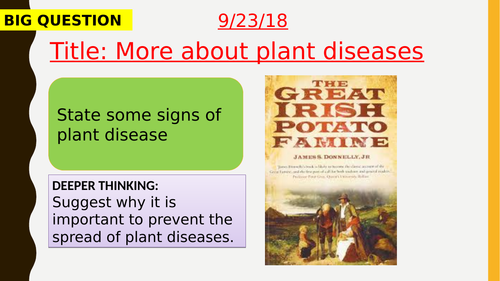
NB: This is a BIOLOGY (SEPARATES) ONLY lesson
More about plant diseases lesson created in accordance to the NEW AQA Specification (9-1). Includes: slide animations, embedded videos, differentiated questions, answers have also been included within the slides. This resource is NOT suitable for combined science students.
AQA spec link: 4.3.3.1
Relevant chapter: B5-Communicable diseases . AQA Biology third edition textbook-Page 92-93.
Plant diseases can be detected by:
• stunted growth
• spots on leaves
• areas of decay (rot)
• growths
• malformed stems or leaves
• discolouration
• the presence of pests.
Identification can be made by: • reference to a gardening manual • taking infected plants to a laboratory to identify the pathogen • using testing kits that contain monoclonal antibodies.
Plants can be infected by a range of viral, bacterial, and fungal pathogens as well as by insects. Knowledge of plant diseases is restricted to tobacco mosaic virus as a viral disease, black spot as a fungal disease, and aphids as insects.
Plants can be damaged by a range of ion deficiency conditions:
• stunted growth caused by nitrate deficiency
• chlorosis caused by magnesium deficiency.
Knowledge of ions is limited to nitrate ions needed for protein synthesis and therefore growth and magnesium ions needed to make chlorophyll.
Get this resource as part of a bundle and save up to 35%
A bundle is a package of resources grouped together to teach a particular topic, or a series of lessons, in one place.
AQA Biology-SEPARATE topics PAPER 1 ONLY
Separate Sciences B5.3, B5.4, B5.10 & B5.11 B6.5 & B6.6
AQA new specification-B5 Communicable diseases-Separate science bundle
This bundle only contains the content for SEPARATE science (BIOLOGY ONLY) students. It includes the B5 unit-communicable diseases. All lessons have been done in accordance to the specification requirements. Videos have been embedded for ease of use, and printer friendly resources attached. Search the individual lessons for more information on the lesson content. Save 35% by purchasing this bundle :) Lesson 1-Heath and disease Lesson 2-Pathogens and disease Lesson 3-Growing bacteria in the lab Lesson 4-RP 2 Microbiology Lesson 5-Preventing bacterial growth Lesson 6-Preventing infections Lesson 7-Viral and bacterial diseases Lesson 8-Diseases caused by fungi and protist Lesson 9-Human defense responses Lesson 10-More about plant diseases Lesson 11-Plant defence responses
Something went wrong, please try again later.
I could have got the text book out and got the students to copy from it by myself, I did not need to pay £3 for the priviledge to be told to do so. I expected more from this resourse.
Report this resourceto let us know if it violates our terms and conditions.
Our customer service team will review your report and will be in touch.
